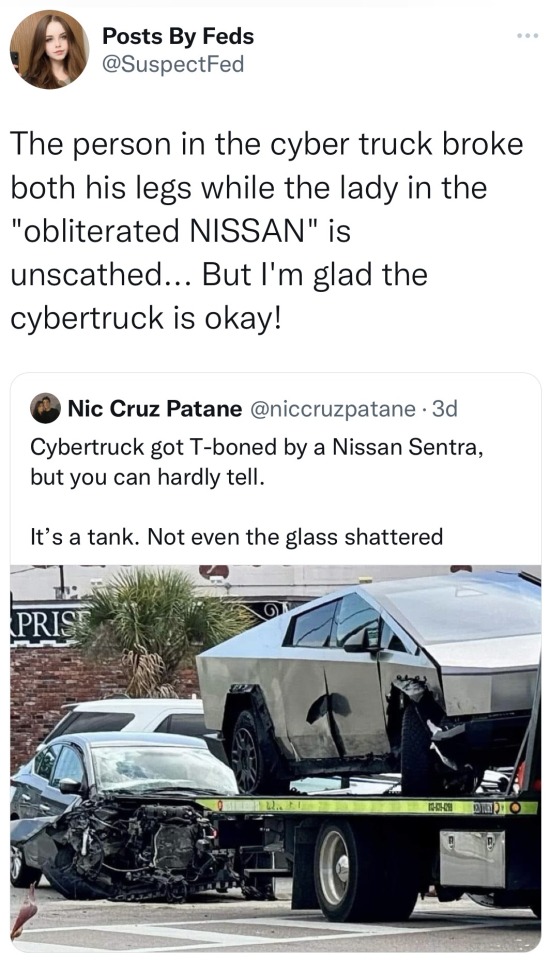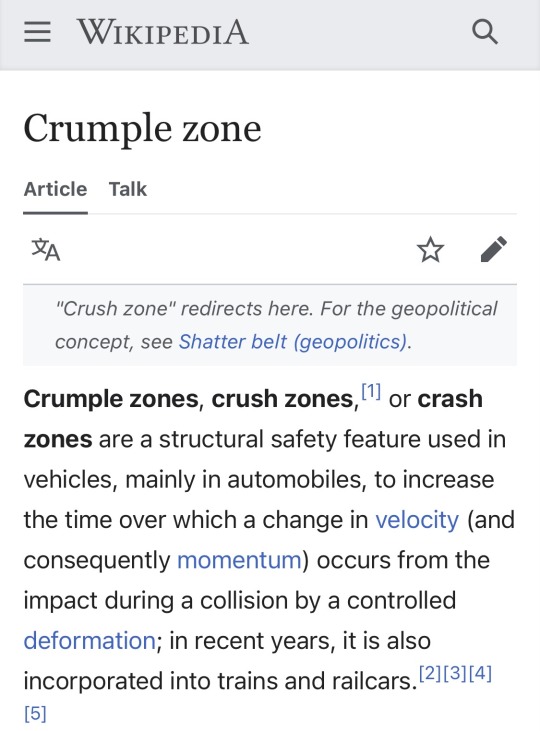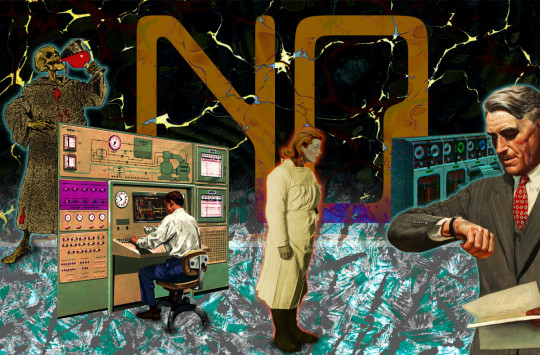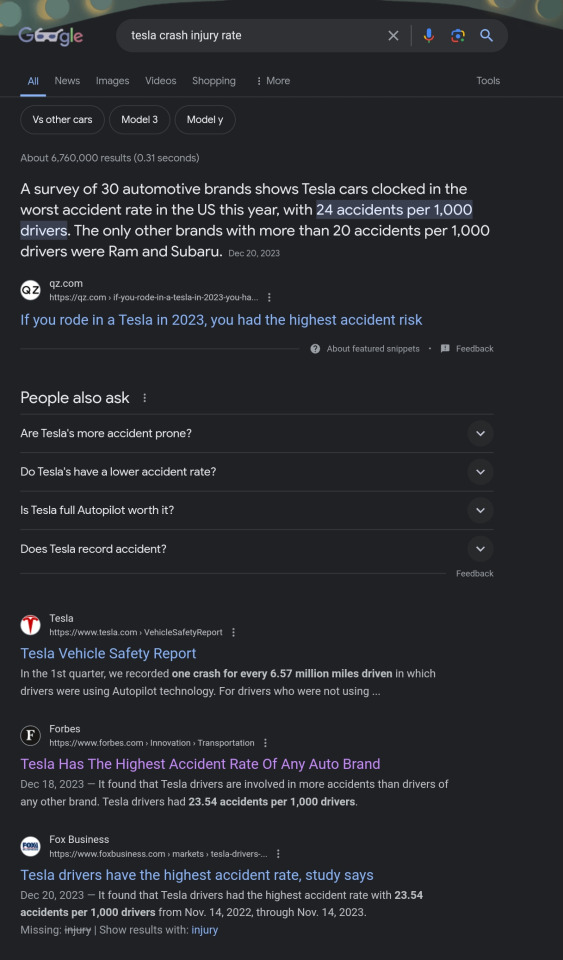#crumple zone
Text



51K notes
·
View notes
Text
“Crumple Zone: Tempered, Tempered”
“Crumple Zone: Tempered, Tempered”

View On WordPress
0 notes
Text
Cigna’s nopeinator

I'm touring my new, nationally bestselling novel The Bezzle! Catch me THURSDAY (May 2) in WINNIPEG, then Calgary (May 3), Vancouver (May 4), Tartu, Estonia, and beyond!

Cigna – like all private health insurers – has two contradictory imperatives:
To keep its customers healthy; and
To make as much money for its shareholders as is possible.
Now, there's a hypothetical way to resolve these contradictions, a story much beloved by advocates of America's wasteful, cruel, inefficient private health industry: "If health is a "market," then a health insurer that fails to keep its customers healthy will lose those customers and thus make less for its shareholders." In this thought-experiment, Cigna will "find an equilibrium" between spending money to keep its customers healthy, thus retaining their business, and also "seeking efficiencies" to create a standard of care that's cost-effective.
But health care isn't a market. Most of us get our health-care through our employers, who offer small handful of options that nevertheless manage to be so complex in their particulars that they're impossible to directly compare, and somehow all end up not covering the things we need them for. Oh, and you can only change insurers once or twice per year, and doing so incurs savage switching costs, like losing access to your family doctor and specialists providers.
Cigna – like other health insurers – is "too big to care." It doesn't have to worry about losing your business, so it grows progressively less interested in even pretending to keep you healthy.
The most important way for an insurer to protect its profits at the expense of your health is to deny care that your doctor believes you need. Cigna has transformed itself into a care-denying assembly line.
Dr Debby Day is a Cigna whistleblower. Dr Day was a Cigna medical director, charged with reviewing denied cases, a job she held for 20 years. In 2022, she was forced out by Cigna. Writing for Propublica and The Capitol Forum, Patrick Rucker and David Armstrong tell her story, revealing the true "equilibrium" that Cigna has found:
https://www.propublica.org/article/cigna-medical-director-doctor-patient-preapproval-denials-insurance
Dr Day took her job seriously. Early in her career, she discovered a pattern of claims from doctors for an expensive therapy called intravenous immunoglobulin in cases where this made no medical sense. Dr Day reviewed the scientific literature on IVIG and developed a Cigna-wide policy for its use that saved the company millions of dollars.
This is how it's supposed to work: insurers (whether private or public) should permit all the medically necessary interventions and deny interventions that aren't supported by evidence, and they should determine the difference through internal reviewers who are treated as independent experts.
But as the competitive landscape for US healthcare dwindled – and as Cigna bought out more parts of its supply chain and merged with more of its major rivals – the company became uniquely focused on denying claims, irrespective of their medical merit.
In Dr Day's story, the turning point came when Cinga outsourced pre-approvals to registered nurses in the Philippines. Legally, a nurse can approve a claim, but only an MD can deny a claim. So Dr Day and her colleagues would have to sign off when a nurse deemed a procedure, therapy or drug to be medically unnecessary.
This is a complex determination to make, even under ideal circumstances, but Cigna's Filipino outsource partners were far from ideal. Dr Day found that nurses were "sloppy" – they'd confuse a mother with her newborn baby and deny care on that grounds, or confuse an injured hip with an injured neck and deny permission for an ultrasound. Dr Day reviewed a claim for a test that was denied because STI tests weren't "medically necessary" – but the patient's doctor had applied for a test to diagnose a toenail fungus, not an STI.
Even if the nurses' evaluations had been careful, Dr Day wanted to conduct her own, thorough investigation before overriding another doctor's judgment about the care that doctor's patient warranted. When a nurse recommended denying care "for a cancer patient or a sick baby," Dr Day would research medical guidelines, read studies and review the patient's record before signing off on the recommendation.
This was how the claims denial process is said to work, but it's not how it was supposed to work. Dr Day was markedly slower than her peers, who would "click and close" claims by pasting the nurses' own rationale for denying the claim into the relevant form, acting as a rubber-stamp rather than a skilled reviewer.
Dr Day knew she was slower than her peers. Cigna made sure of that, producing a "productivity dashboard" that scored doctors based on "handle time," which Cigna describes as the average time its doctors spend on different kinds of claims. But Dr Day and other Cigna sources say that this was a maximum, not an average – a way of disciplining doctors.
These were not long times. If a doctor asked Cigna not to discharge their patient from hospital care and a nurse denied that claim, the doctor reviewing that claim was supposed to spend not more than 4.5 minutes on their review. Other timelines were even more aggressive: many denials of prescription drugs were meant to be resolved in fewer than two minutes.
Cigna told Propublica and The Capitol Forum that its productivity scores weren't based on a simple calculation about whether its MD reviewers were hitting these brutal processing time targets, describing the scores as a proprietary mix of factors that reflected a nuanced view of care. But when Propublica and The Capitol Forum created a crude algorithm to generate scores by comparing a doctor's performance relative to the company's targets, they found the results fit very neatly into the actual scores that Cigna assigned to its docs:
The newsrooms’ formula accurately reproduced the scores of 87% of the Cigna doctors listed; the scores of all but one of the rest fell within 1 to 2 percentage points of the number generated by this formula. When asked about this formula, Cigna said it may be inaccurate but didn’t elaborate.
As Dr Day slipped lower on the productivity chart, her bosses pressured her bring her score up (Day recorded her phone calls and saved her emails, and the reporters verified them). Among other things, Dr Day's boss made it clear that her annual bonus and stock options were contingent on her making quota.
Cigna denies all of this. They smeared Dr Day as a "disgruntled former employee" (as though that has any bearing on the truthfulness of her account), and declined to explain the discrepancies between Dr Day's accusations and Cigna's bland denials.
This isn't new for Cigna. Last year, Propublica and Capitol Forum revealed the existence of an algorithmic claims denial system that allowed its doctors to bulk-deny claims in as little as 1.2 seconds:
https://www.propublica.org/article/cigna-pxdx-medical-health-insurance-rejection-claims
Cigna insisted that this was a mischaracterization, saying the system existed to speed up the approval of claims, despite the first-hand accounts of Cigna's own doctors and the doctors whose care recommendations were blocked by the system. One Cigna doctor used this system to "review" and deny 60,000 claims in one month.
Beyond serving as an indictment of the US for-profit health industry, and of Cigna's business practices, this is also a cautionary tale about the idea that critical AI applications can be resolved with "humans in the loop."
AI pitchmen claim that even unreliable AI can be fixed by adding a "human in the loop" that reviews the AI's judgments:
https://pluralistic.net/2024/04/23/maximal-plausibility/#reverse-centaurs
In this world, the AI is an assistant to the human. For example, a radiologist might have an AI double-check their assessments of chest X-rays, and revisit those X-rays where the AI's assessment didn't match their own. This robot-assisted-human configuration is called a "centaur."
In reality, "human in the loop" is almost always a reverse-centaur. If the hospital buys an AI, fires half its radiologists and orders the remainder to review the AI's superhuman assessments of chest X-rays, that's not an AI assisted radiologist, that's a radiologist-assisted AI. Accuracy goes down, but so do costs. That's the bet that AI investors are making.
Many AI applications turn out not to even be "AI" – they're just low-waged workers in an overseas call-center pretending to be an algorithm (some Indian techies joke that AI stands for "absent Indians"). That was the case with Amazon's Grab and Go stores where, supposedly, AI-enabled cameras counted up all the things you put in your shopping basket and automatically billed you for them. In reality, the cameras were connected to Indian call-centers where low-waged workers made those assessments:
https://pluralistic.net/2024/01/29/pay-no-attention/#to-the-little-man-behind-the-curtain
This Potemkin AI represents an intermediate step between outsourcing and AI. Over the past three decades, the growth of cheap telecommunications and logistics systems let corporations outsource customer service to low-waged offshore workers. The corporations used the excuse that these subcontractors were far from the firm and its customers to deny them any agency, giving them rigid scripts and procedures to follow.
This was a very usefully dysfunctional system. As a customer with a complaint, you would call the customer service line, wait for a long time on hold, spend an interminable time working through a proscribed claims-handling process with a rep who was prohibited from diverging from that process. That process nearly always ended with you being told that nothing could be done.
At that point, a large number of customers would have given up on getting a refund, exchange or credit. The money paid out to the few customers who were stubborn or angry enough to karen their way to a supervisor and get something out of the company amounted to pennies, relative to the sums the company reaped by ripping off the rest.
The Amazon Grab and Go workers were humans in robot suits, but these customer service reps were robots in human suits. The software told them what to say, and they said it, and all they were allowed to say was what appeared on their screens. They were reverse centaurs, serving as the human faces of the intransigent robots programmed by monopolists that were too big to care.
AI is the final stage of this progression: robots without the human suits. The AI turns its "human in the loop" into a "moral crumple zone," which Madeleine Clare Elish describes as "a component that bears the brunt of the moral and legal responsibilities when the overall system malfunctions":
https://estsjournal.org/index.php/ests/article/view/260
The Filipino nurses in the Cigna system are an avoidable expense. As Cigna's own dabbling in algorithmic claim-denial shows, they can be jettisoned in favor of a system that uses productivity dashboards and other bossware to push doctors to robosign hundreds or thousands of denials per day, on the pretense that these denials were "reviewed" by a licensed physician.

If you'd like an essay-formatted version of this post to read or share, here's a link to it on pluralistic.net, my surveillance-free, ad-free, tracker-free blog:
https://pluralistic.net/2024/04/29/what-part-of-no/#dont-you-understand
#pluralistic#cigna#computer says no#bossware#moral crumple zones#medicare for all#m4a#whistleblowers#dr debby day#Madeleine Clare Elish#automation#ai#outsourcing#human in the loop#humans in the loop
155 notes
·
View notes
Text
"a computer cannot be held accountable, therefore a computer must not make a management decision"
this always seemed like a weird statement to me, more based on being snappy than any logic. the people who programmed the computer can be "accountable". the people who designed the system that the computer integrates it with can be accountable. does the tragedy of therac-25 means that we should never use computers in a medical context, since we couldn't put the therac-25 on trial?
if your concern is that the computer acts as an impenetrable "blame absorber", then consider that people have been doing this with "i'm just following the rules" for centuries, and people rarely suggests that this means we should abolish structure. consider all the times that a systemic flaw has been excused as "we found the single person responsible for all these problems and got rid of them", or the fact that in industrial accident analysis care has to be taken to avoid just letting all the blame attach itself to whatever human was most proximal.
28 notes
·
View notes
Photo

316 notes
·
View notes
Text
i feel like bertrand is the kind of guy who would delightedly drive a station wagon, but beatrice refuses to let him. a station wagon is too basic. this is how bertrand winds up with a 1960 chevy nomad wagon, sky blue. meanwhile, beatrice drives a red 1960 ford starliner
additionally kit drives a black 1950 cadillac series 62 coupe deville
#i love station wagons.......but i also feel like. station wagons are so.........specific. like. god it's such a specific dad family car#beatrice 1) wants a good family car but also 2) refuses a regular station wagon.#the chevy nomad wagon had style.#once again lulu vandelay googles cars instead of making words but no regerts. have you seen these cars?? gorgeous.#HERE'S THE THING. I HAVE ZERO INTEREST IN CARS. I'M NOT A CAR PERSON. AT ALL.#but i like looking at old cars and picking out what i think characters would drive.#best friend: OLD CARS DON'T HAVE CRUMPLE ZONES#me thinking as best friend keeps talking about crumple zones: .........but they have such personality.............so boxy........ :(#anyway last week was how i learned about crumple zones!!#i mean i knew about like the idea of them but not like. the term for them. the real concept of it#lulu talks about the sad lemon man#I KEEP FORGETTING TO USE MY TAG. I HAVE MISSED PUTTING SUCH JOYOUS NUGGETS IN MY LEMON MAN TAG PROBABLY. MY APOLOGIES
16 notes
·
View notes
Text

I wanted to see if there were any statistics comparing severity of the injuries from the crashes as well but i suppose being the most dangerous brand of vehicle on the road sort of encompasses having life threatening accidents as well.
#tesla#cybertruck#elon musk#tesla is a failed car company kill them#actually endagering our kids to a signifigant detectable amount#not only is it the most likely to get in a car wreck its also the moet likely to break your legs or spine cause no crumple zones
4 notes
·
View notes
Text
Cybertruck spotted. I wonder who would win... 10klb chevy with winch and deer gaurd or cybertruck
3 notes
·
View notes
Text
I really wasnt expecting that anti-apple post to get notes sgdgdgdg I feel so validated 😭💕
#marquilla#i mean androids could be better too but at least theres variety and you can customize it without 'jail breaking'#also we can have ad block on our phones 😎 get fucked 🤙#teslas and iphones are two things tech bros (gender neutral) loooove to have and it's so funny in a cringey way like okay enjoy your death#trap on wheels and your gonna break in 3 years phone. you got me! im a broke bitch! 🙄#BaldBastard has both as well as my aunts husband well he rents them when they rent cars but it's like yall are so lame agdgdgdgd#like im sorry but you could be the coolest person on the planet but the second you have either or god forbid both of those you turn into a#fucking loser sgdgdgdg (and again im mocking apple elitists not people who happen to own iphones and are normal ab it)#he didnt get to rent a Tesla last time they came in and he was SO MAD they gave him a hybrid car not a tesla bc he wanted 'the Tesla#experience' and i had to literally bite my tongue to keep myself from saying 'oh you mean burning to death or drowning bc the self driving#system crashed into a building or drove off a bridge?' SO HARD SGDGGDGDGDGD i was like 😐 agsgdggdgdgd#oh or did you want the tesla experience where you rearend someone on the highway and are thrown out the windshield bc theres no#crumple zones? that experience?#they ofc all have apple watches and are CONSTANTLY checking them for notifications its so fucking rude
3 notes
·
View notes
Text
I'm very much a car guy but i don't think you need to be one to understand how crumple zones work and why they're great and it's painful seeing people ignore how important they are
#this is about the cybertruck#if it actually has a crumple zone it is small enough that it doesn't do jack shit#all that force has to go somewhere and if its not through the car then it's through the passengers!!#the rig i drive doesn't have any and i have to be really aware of it!!!#a head-on crash in a car with a crumple zone the driver would be okay#the same crash in mine would likely kill me#structural integrity isn't shit when it's going to kill you!#had to rant#was showing off how cybertruck would kill you to my dad and apparently he doesn't understand why crumple zones are important!#compared them to semis saying that you don't need to worry about your rig crumpling when you're the bigger rig#bein a bigger rig doesnt mean shit when you ram into a wall & the crumple zone does its job stopping the engine from obliterating your skull#screaming#atropos speaks (fake) prophecies
6 notes
·
View notes
Text
The real difference between the first time I read Twilight and now is that I keep going ‘don’t you need a parental signature to do that? You’re seventeen.’
#the other half of me is wondering how many people have died driving Bella’s indestructible truck#on account of the laws of physics etc#probably how Billy ended up in a wheelchair#he went through the damn windscreen because the truck has no crumple zone
13 notes
·
View notes
Text
The cyber truck is quite possibly the most idiotic thing I’ve ever seen gods I cannot stand Elon musk
#fish out of water convos#cyber truck#how the hell is it even street legal?#it’ll kill someone 💀 no crumple zones and just a goddamn tank
6 notes
·
View notes
Text
Tesla: "INTRODUCING THE INDESTRUCTIBLE CYBERTRUCK!"
Tumblrinas who have seen that one Tumblr post twice a year every year:

#tbh you dont need to know about crumple zones or even Tesla's track record#to realize that thing is the world's ugliest death trap#you can look at it with zero physics knowledge and feel very strongly that every shape within and outside it is designed to kill you#a microwave on wheels has less bad juju#elongated muskrat#tumblr university#cars#tesla#tumblr culture#capitalism#knee of huss
15 notes
·
View notes
Text
yeah listening to i’m on fire on the train and yeah. i am on fire actually. i’m so on fire that no one can even come close lest they melt and explode. if you get me
#that moment when u get the train from the end of the line going toward the city and even tho its peak time theres no one on it#and u sit in ur fav corner seat and no one gets anywhere close and its like ur alone in this steel shell with a mile long crumple zone#and no one else even comes close#but maybe they should. Idk
3 notes
·
View notes
Text
i still maintain to this day that ko/-maeda sucks as a character and driving force in sd/-r2. i dont like him. theres nothing ko/-maeda does that ou/-ma doesnt do significantly better
#spitblaze says things#including:#being explicitly mlm#moral gray zone bullshit#not relying on ur weirdass RNG for plans to work#having a backstory that. like. makes some amount of sense#having a design that doesnt make me want to crumple them in a ball and toss them in the trash [derogatory]#etc etc#i also dont like ko/-mahi/-na still to this day but that ones more petty#(i simply think Super Toxic Relationships are not fun to explore or consider personally)
4 notes
·
View notes
Text
I have to say, as a car accident survivor when I heard the glass breaking and metal crunching from that accident earlier my heart sank and I assumed the worst. I was so relieved when I turned around and saw that two cars had just backed into each other in a carpark, and while the back of one had caved in, no one was hurt
I don't know if I've gotten better or worse with accidents
2 notes
·
View notes